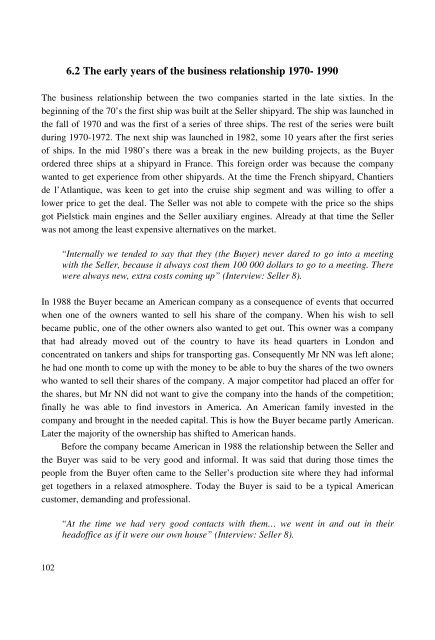Value Co-Creation in Industrial Buyer-Seller Partnerships ... - Doria
Value Co-Creation in Industrial Buyer-Seller Partnerships ... - Doria
Value Co-Creation in Industrial Buyer-Seller Partnerships ... - Doria
- No tags were found...
Create successful ePaper yourself
Turn your PDF publications into a flip-book with our unique Google optimized e-Paper software.
6.2 The early years of the bus<strong>in</strong>ess relationship 1970- 1990The bus<strong>in</strong>ess relationship between the two companies started <strong>in</strong> the late sixties. In thebeg<strong>in</strong>n<strong>in</strong>g of the 70’ s the first ship was built at the <strong>Seller</strong> shipyard. The ship was launched <strong>in</strong>the fall of 1970 and was the first of a series of three ships. The rest of the series were builtdur<strong>in</strong>g 1970-1972. The next ship was launched <strong>in</strong> 1982, some 10 years after the first seriesof ships. In the mid 1980’ s there was a break <strong>in</strong> the new build<strong>in</strong>g projects, as the <strong>Buyer</strong>ordered three ships at a shipyard <strong>in</strong> France. This foreign order was because the companywanted to get experience from other shipyards. At the time the French shipyard, Chantiersde l’ Atlantique, was keen to get <strong>in</strong>to the cruise ship segment and was will<strong>in</strong>g to offer alower price to get the deal. The <strong>Seller</strong> was not able to compete with the price so the shipsgot Pielstick ma<strong>in</strong> eng<strong>in</strong>es and the <strong>Seller</strong> auxiliary eng<strong>in</strong>es. Already at that time the <strong>Seller</strong>was not among the least expensive alternatives on the market.“ Internally we tended to say that they (the <strong>Buyer</strong>) never dared to go <strong>in</strong>to a meet<strong>in</strong>gwith the <strong>Seller</strong>, because it always cost them 100 000 dollars to go to a meet<strong>in</strong>g. Therewere always new, extra costs com<strong>in</strong>g up” (Interview: <strong>Seller</strong> 8).In 1988 the <strong>Buyer</strong> became an American company as a consequence of events that occurredwhen one of the owners wanted to sell his share of the company. When his wish to sellbecame public, one of the other owners also wanted to get out. This owner was a companythat had already moved out of the country to have its head quarters <strong>in</strong> London andconcentrated on tankers and ships for transport<strong>in</strong>g gas. <strong>Co</strong>nsequently Mr NN was left alone;he had one month to come up with the money to be able to buy the shares of the two ownerswho wanted to sell their shares of the company. A major competitor had placed an offer forthe shares, but Mr NN did not want to give the company <strong>in</strong>to the hands of the competition;f<strong>in</strong>ally he was able to f<strong>in</strong>d <strong>in</strong>vestors <strong>in</strong> America. An American family <strong>in</strong>vested <strong>in</strong> thecompany and brought <strong>in</strong> the needed capital. This is how the <strong>Buyer</strong> became partly American.Later the majority of the ownership has shifted to American hands.Before the company became American <strong>in</strong> 1988 the relationship between the <strong>Seller</strong> andthe <strong>Buyer</strong> was said to be very good and <strong>in</strong>formal. It was said that dur<strong>in</strong>g those times thepeople from the <strong>Buyer</strong> often came to the <strong>Seller</strong>’ s production site where they had <strong>in</strong>formalget togethers <strong>in</strong> a relaxed atmosphere. Today the <strong>Buyer</strong> is said to be a typical Americancustomer, demand<strong>in</strong>g and professional.“ At the time we had very good contacts with them… we went <strong>in</strong> and out <strong>in</strong> theirheadoffice as if it were our own house” (Interview: <strong>Seller</strong> 8).102
















